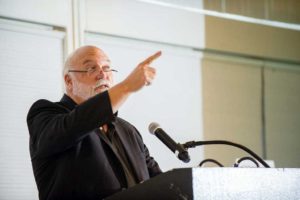One hundred magazine publishing professionals gathered this past October for the second annual Lane Press Publishers’ Conclave. The two-day event featured nine stand-out speakers with very different stories to tell — from an investment industry exec-turned-publisher reporting on the progress of his title acquisition and overhaul, to a Pulitzer Prize-winning alumni editor extolling the virtue of continually asking, relative to your magazine, Why? and Why not? We had a thriller novelist who brings the spirit of suspense and intrigue to … wait for it … insurance industry publishing, and even a regional publishing editor detailing the story behind the closure of her magazine. Attendees brainstormed, debated, disagreed, and most importantly, walked away with ideas to put to work. If you didn’t make it to the 2017 Conclave, we have this for you: A piece of wisdom from each of our speakers that you can read today and implement tomorrow. So, what are you waiting for?
“Anything you do that’s good content should be usable in more than one channel. If you have a podcast, that’s great, but how can you present that content in your magazine? Can you take it and do a Q&A or expert tips? This is a mind-shift. How can you do more with what you’re already producing? The challenge is to get people across your organization to think this way.”
– Scott Hauser, Editor, Rochester Review
“There’s an expression in the venture capital world, where I come from: ‘Fail fast.’ Make a mistake, learn from it, pivot, regroup, and move on. Publishers should apply this philosophy to what they’re doing every single day.”
– Jeff Joseph, Chief Editor & Publisher, Modern Trader
“At the end of the day, you’re either a business or a charity. You’re either there to make money or to give freely. Nothing is wrong with either, but you have to pick. You have to be able to point back to the cornerstone of why you exist so you have that platform to help make decisions. American entrepreneur Roy E. Disney is quoted as saying, ‘It’s not hard to make decisions when you know what your values are.’ So, ask yourself, why do you exist?”
– Jordana Megonigal, Director of Brand Engagement, The Brand Leader
“To figure out whether events will work for your brand, look at your core constituencies and identify the needs among them that aren’t being addressed by anyone. What types of events can you host that both leverage your strengths and meet these needs? That’s the sweet spot.”
– Kyle Hoepner, Editor in Chief, New England Home
“Our branded content program is a win-win-win (for NACS, our readers, and our advertisers) when we adhere to clear and specific guardrails: Total transparency using labeling, and making the sure the quality of the content syncs with our platform and voice. These firm practices enable us to defend the value of what we’re doing internally and keep our advertisers’ expectations very clear.”
– Erin Pressley, Vice President of Publishing, NACS Media Group
“When it comes to storytelling ideas, ask yourself, ‘Why not?’ In our case, why not adapt a treatment from a consumer magazine in our alumni one? Why not assign a staff writer to report on the university’s soup-to-nuts production of Shakespeare’s ‘Love’s Labour’s Lost’ (all 74 days of it)? And perhaps the pinnacle of why not for us, why not feature a photo of a dead hamster in a purse? Be willing to experiment in service to your audience.”
– Maria Henson, Associate Vice President & Editor at Large, Wake Forest Magazine
“The growth of digital media has encouraged copying. It tells you, ‘Go ahead, capture this and send it to whoever you want.’ As editors and publishers, you should have an understanding of the copyright law, the fair use standard, and the role of digital rights management. As your publications become more and more interactive, more digital, more online as well as in print, these issues are of increasing importance.”
– Harvey R. Levenson, Ph.D., Professor Emeritus & Past Head of Graphic Communication, Cal Poly San Luis Obispo
“Every journalist knows that no matter what you write, someone will be unhappy. So why try to make everyone happy? Try to make them read instead. The New Yorker and The Atlantic’s long-form stories are compelling, they take sides, they piss people off, but most of all — and this is most important – they are read. And guess what? Advertisers follow readers.”
– Rick Pullen, Editor in Chief, Leader’s Edge
“Using a ‘mobile first’ approach when redesigning your publication’s website forces you to prioritize your content and create a hierarchy. When you design for desktop, you tend to get caught up in silly discussions about ‘what is above the fold,’ when the mysterious ‘fold’ has not existed on the web in years. The mobile-first approach helps you focus on what is most important and leads to the best, clearest design.”
– Alissa Levin, Founder & Creative Director, Point Five Design







